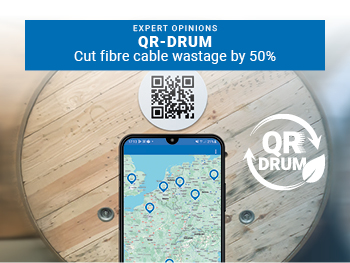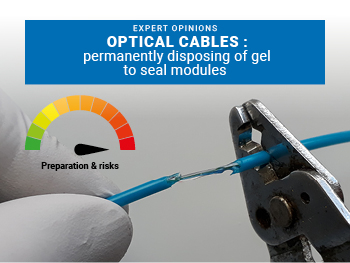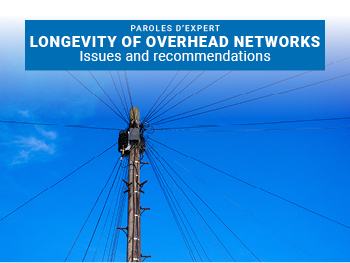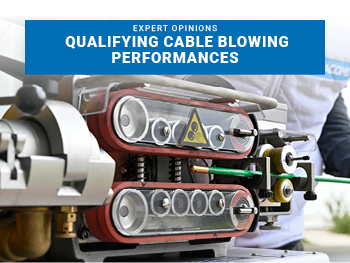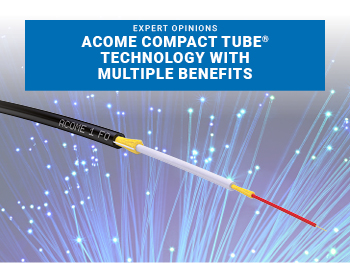Nanomodule for the UK : a breakthrough technology fighting back against rollout inflation costs
Due to the UK’s ambition to offer countrywide broadband technology, the demand for fibre connectivity is accelerating. According to IDATE's 2022 forecasts, 7 million homes are already connectable to FTTH and the fibre rollout will continue to accelerate until 2027, reaching up to 30 million homes. The strong demand concerns urban areas and less dense areas alike, and for the latter, aerial deployment is the most likely method for fibre cable installation. Due to environmental effects, aerial cables are dimensionally constrained to a diameter of 7 mm, which with established ULW cable construction, limits the cables to a maximum of 48 fibres. However, with the introduction of ACOME’s new and patented Nanomodule technology, this constraint is removed, significantly increasing the cable capacity, whilst maintaining both the 12x250µm modules and the 7 mm cable diameter.
Increased fibre capacity inside the same diameter
In the UK, for operators to use the PIA infrastructure, their cables must comply with the rules laid down in the PIA guide. The rules include cable breaking loads and cable size. The two constraints together create a significant challenge to cable design and consequently limited the number of fibres that can be contained within a cable sheath that contains breakable strength members. To overcome the challenge cable providers have been forced to move away from 250µm fibres to the smaller 200µm and to increase the number of fibres inside the modules. This impacts the installation practices of the installer as they move from the conventional 12 FO per module to 24 FO per module. This introduces ring marking on the fibres and additional fibre management onto the splice trays.
Despite these constraints, to meet the ambitious FTTH rollout schedule, denser cables, that are faster and cheaper to install and bring ecological advantage are pushing cable technology to new realms. The ACOME patented nanomodule not only increases the cable density between 80 and 100 %, when compared with convention micromodule and loose tube designs, but it reduces the cable carbon footprint, reduces installation times, and reduces the TCO.

Reduction to the Total Cost of Ownership (TCO) : CAPEX et OPEX
The ACOME patented nanomodule design reduces the Total Cost of Ownership. As an example consider that a 72-fibre cable is used instead of two 36-fibre cables. In this scenario, the CAPEX is reduced by 33 %, as shown in the graph below. This represents a saving of over £1000 per kilometre deployed.

Additionally, the TCO is further reduced as the use of a single cable allows for a reduction in the annual PIA rental costs. Moreover, as deployment is faster, this improves your overall cost of ownership (TCO) and also reduces delays (penalties and marketing of subscriptions).
The ULW cable, built using ACOME patented nanomodule; a solution to meet the challenges of the market
A 12 FO module of 250µm fibres is ~30 % smaller than a micro loose tube, when constructed using the ACOME patented nanomodule. This miniaturisation makes it possible to increase the cable density as described previously.

Dry modules; Reducing fibre preparation times and reducing pollution
Conventional fibre modules are generally sealed against moisture proliferation by using gel or grease. The ACOME patented nanomodule technology is gel and grease free, with the cable completely moisture blocked by water swellable yarns. The elimination of sealing gel or grease negates fibre cleansing, reducing the fibre preparation times, by as much five minutes per module. Additionally, the fibre cleaning solvents are no longer required, avoiding waste pollution from both the sealing and cleansing substances. General handling is easier, with cleaner hands, optical trays and fibre storage units.
The ACOME patented nanomodule allows simplified, fast access to the fibre and inline fibre splicing
Thanks to the direct fibre access, it is possible to avoid cutting the whole module in mid-span. The simplified access eliminates the need to strip the module and significantly reduces the risk of breakage or kinking. The integrity of the fibre is thus preserved, guaranteeing its life span.
Inline fibre splicing is reduced by directly accessing the necessary fibres, without the need to introduce additional splice units. A spliced fibre increases the attenuation by approximately 0.1dB for every splice within the same fibre length. Not only does it save on installation times, in the realms of two to three minutes per splice, saving between one and two hours dependent on the fibre count, but it also helps to maintain the optical budget.
A new technology that reduces the environmental impact of your infrastructure
The ACOME patented nanomodule offers an environmental gain: - 15 kg CO2 eq/km per module compared to micro loose tube and even more when compared to other current dense structures. In addition, this innovation reduces the environmental footprint of your entire deployment. Comparing the deployment of a 96-fibres ULW cable with two 48-fibres cables, the carbon footprint of the deployment is reduced by 150 kg CO2 eq/km or 24 %. (Save up to 31% with ULW new cables compared to current configurations).
A more sustainable infrastructure
Finally, the ULW 72 FO Nanomodule will allow you to build a sustainable network without overloading the poles. With less stress on the poles, the infrastructure becomes less vulnerable to wind and other weather events and offers extended growth capacity.

